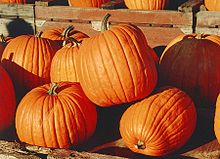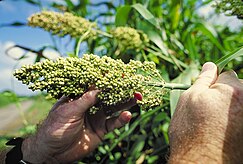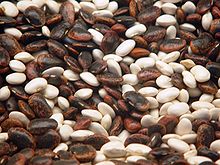
Eswatini, officially the Kingdom of Eswatini and also known as Swaziland, is a landlocked country in Southern Africa. It is bordered by Mozambique to its northeast and South Africa to its north, west and south. At no more than 200 kilometres (120 mi) north to south and 130 kilometres (81 mi) east to west, Eswatini is one of the smallest countries in Africa; despite this, its climate and topography are diverse, ranging from a cool and mountainous highveld to a hot and dry lowveld.

Porridge is a food commonly eaten as a breakfast cereal dish, made by boiling ground, crushed or chopped starchy plants—typically grain—in water or milk. It is often cooked or served with added flavorings such as sugar, honey, fruit or syrup to make a sweet cereal or mixed with spices or vegetables to make a savoury dish. It is usually served hot in a bowl.

The Swazi or Swati are a Bantu ethnic group of Southern Africa, predominantly inhabiting modern Eswatini and South Africa's Mpumalanga province. The Swati are part of the Nguni family that can be archaeologically traced in East Africa where the same tradition, beliefs and cultural practices are found. The Swati share a unique experience, culture and Royal lineage. This lineage is exclusive to the inhabitants of Eswatini, even though there have been more Swazi people that have moved to South Africa and the United Kingdom in the 20th century. The original inhabitants of Eswatini no longer reside in Eswatini as a majority population while some remain in the land. The Swazi people and the Kingdom of Eswatini today are named after Mswati II, who became king in 1839 after the death of his father King Sobhuza who strategically defeated the British who occupied Swaziland. The Kingdom of Swaziland was a region occupied by the San people of Southern Africa and the current Swazis came in from North Eastern regions through to Mozambique and eventually Swaziland in the 15th century. Mixtures with the San people and other Nguni tribes occurred. Their royal lineage can be traced to a chief named Dlamini I; this is still the royal clan name. About three-quarters of the clan groups are Nguni; the remainder are Sotho, Tsonga, others North East African and San descendants. These groups have intermarried freely. There are slight differences among Swazis as a nation with varying features and skin tones yet Swazi identity extends to all those with allegiance to the twin monarchs Ingwenyama "the Lion" and Indlovukati "the She-Elephant". The dominant Swati language and culture are factors that unify Swazis as a nation since there is no other language spoken except for English.
Traditionally, the various cuisines of Africa use a combination of locally available fruits such as, cereal grains and vegetables, as well as milk and meat products, and do not usually have food imported. In some parts of the continent, the traditional diet features an abundance of milk, curd and whey products.

Ugali is a type of cornmeal porridge made in Africa. It is also known as ngima,'obusuma'nshima, Mieliepap, phutu, sadza, and other names. It is sometimes made from other flours, such as millet or sorghum flour, and is sometimes mixed with cassava flour. It is cooked in boiling water or milk until it reaches a stiffy or firm dough-like consistency.

Ugandan cuisine consists of traditional and modern cooking styles, practices, foods and dishes in Uganda, with English, Arab, and Asian influences.

The cuisine of Botswana is unique but also shares some characteristics with other cuisines of Southern Africa. Examples of Setswana food include pap, samp, vetkoek, and mopane worms. A food unique to Botswana is seswaa, salted mashed-up meat. Watermelons are believed to have originated in Botswana.

The cuisine of the Democratic Republic of the Congo varies widely, representing the food of indigenous people. Cassava is generally the staple food usually eaten with other side dishes.

Ghanaian cuisine is the cuisine of the Ghanaian people. Ghanaian main dishes are organized around a starchy staple food, with which goes a sauce or soup containing a protein sauce. The main ingredient for the vast majority of soups and stews are tomatoes- canned or fresh tomatoes can be used. As a result, nearly all Ghanaian soups and stews are red or orange in appearance.

Nigerian cuisine consists of dishes or food items from the hundreds of ethnic groups that comprise Nigeria. Like other West African cuisines, it uses spices and herbs with palm or groundnut oil to create deeply flavored sauces and soups. Nigerian feasts are colourful and lavish, while aromatic market and roadside snacks cooked on barbecues or fried in oil are plentiful and varied.

The following outline is provided as an overview of and topical guide to Eswatini:

Burkinabé cuisine, the cuisine of Burkina Faso, is similar to the cuisines in many parts of West Africa, and is based on staple foods of sorghum, millet, rice, fonio, maize, peanuts, potatoes, beans, yams and okra. Rice, maize and millet are the most commonly eaten grains. Grilled meat is common, particularly mutton, goat, beef and fish. Vegetables include, besides yams and potatoes, okra, tomatoes, zucchini, carrots, leeks, onions, beets, pumpkins, cucumbers, cabbage, sorrel and spinach. Although imported products are becoming more common in urban areas, meals in more rural areas typically consist of tô, a sauce of corchorus or baobab leaves, as well as the calyx from Bombax costatum, dried fish, and spices such as chili and soumbala.
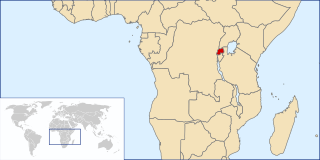
The cuisine of Rwanda is based on local staple foods produced by the traditional subsistence-level agriculture and has historically varied between the country's different ethnic groups.
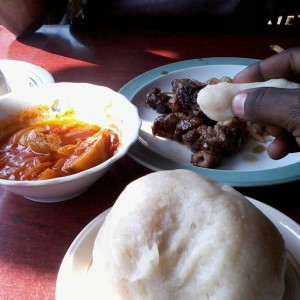
Burundi is situated in East Africa and has a territory full of mountains, savannas and agricultural fields, with forests in the surrounding of rivers and waters. Agriculture is spread on 80% of the country's surface and it especially includes coffee, tea, corn, beans and manioc. Due to these characteristics, the Burundi cuisine is very representative of the African culinary culture, as it includes beans, which are the staple of Burundi cooking, exotic fruits plantains, sweet potatoes, cassava, peas, maize and cereals, like corn and wheat. Profiteroles are also sometimes enjoyed as a rare delicacy. Not much meat is consumed in Burundi, because animal breeding is a secondary occupation; still, there are some dishes that include goat and sheep meat but cows are very sacred.
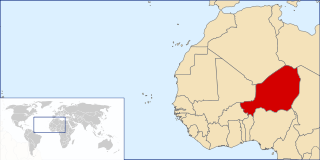
The cuisine of Niger takes after many traditional African cuisines, and a significant amount of spices are used in dishes. Grilled meat, seasonal vegetables, salads and various sauces are some of the foods consumed.

Chadian cuisine is the cooking traditions, practices, foods and dishes associated with the Republic of Chad. Chadians use a medium variety of grains, vegetables, fruits and meats. Commonly consumed grains include millet, sorghum, and rice as staple foods. Commonly eaten vegetables include okra and cassava. A variety of fruits are also eaten. Meats include mutton, chicken, pork, goat, fish, lamb and beef. The day's main meal is typically consumed in the evening on a large communal plate, with men and women usually eating in separate areas. This meal is typically served on the ground upon a mat, with people sitting and eating around it.

Togolese cuisine is the cuisine of the Togolese Republic, a country in Western Africa. Staple foods in Togolese cuisine include maize, rice, millet, cassava, yam, plantain and beans. Maize is the most commonly consumed food in the Togolese Republic. Fish is a significant source of protein, and bush meat is often hunted and consumed. People in Togo tend to eat at home, but there are also restaurants and food stalls.

Malawian cuisine includes the foods and culinary practices of Malawi. Tea and fish are popular features of Malawian cuisine. Sugar, coffee, corn, potatoes, sorghum, cattle and goats are also important components of the cuisine and economy. Lake Malawi is a source of fish including chambo usipa, mpasa. Nsima is a staple food made from ground corn and served with side dishes of meat, beans and vegetable. It can be eaten for lunch and dinner.
The cuisine of Mozambique has deeply been influenced by the Portuguese, who introduced new crops, flavorings, and cooking methods. The staple food for many Mozambicans is ncima, a thick porridge made from maize/corn flour. Cassava and rice are also eaten as staple carbohydrates. All of these are served with sauces of vegetables, meat, beans or fish. Other typical ingredients include cashew nuts, onions, bay leaves, garlic, coriander, paprika, pepper, red pepper, sugar cane, corn, millet, sorghum and potatoes.





